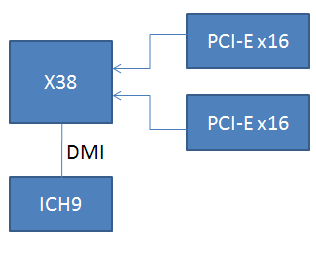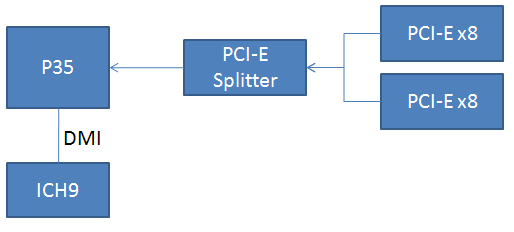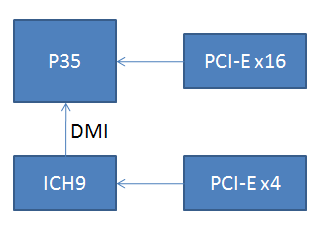PCI-Express Lanes, Explained

PCI-Express layout in the Intel X38-based Asus P5E3 Deluxe WiFi-AP @n
It's also worth noting where the PCI-Express lanes come from so we can look at their potential latency: The Asus P5E3 Deluxe WiFi AP @n, Intel X38 board runs both x16 lanes direct from the northbridge, which is inherently quicker, being all on one chip and having direct access to both the CPU and memory. In comparison the Asus Blitz Extreme P35 board runs both its x8 lanes from the northbridge, but the data still has to navigate through a PCI-Express splitter chip in between, increasing the latency.

PCI-Express layout in the Intel P35-based Asus Blitz Extreme
Finally our MSI P35 Diamond (P35) board has an unbalanced x16 and x4 combination, which not only means there's an obvious bottleneck in the x4 bandwidth, but the data has to go into the southbridge and share the northbridge-southbridge DMI before meeting with the other card's data. Its latency is far greater making it the most inefficient solution, and because of this, even MSI doesn't advertise CrossFire as being a feature on its P35 Diamond. We're using it here simply because it can do it and it's also DDR3 capable so we can keep the systems as even as possible.

PCI-Express layout in the Intel P35-based MSI P35 Diamond
Test Systems

This testing was done before the latest ATI Catalyst 7.10 drivers we made available yesterday evening, which offer some quite significant improvements in both Enemy Territory: Quake Wars and World in Conflict. However, the overall message will remain the same as the hard-wired bandwidth between the cards is unaffected.
Game Selection
- Call of Duty 2 (v1.2)
- Enemy Territory - Quake Wars (v1.1)
- F.E.A.R. (v1.08)
- Supreme Commander (v3223)
- World in Conflict (v1.001)

MSI MPG Velox 100R Chassis Review
October 14 2021 | 15:04









Want to comment? Please log in.